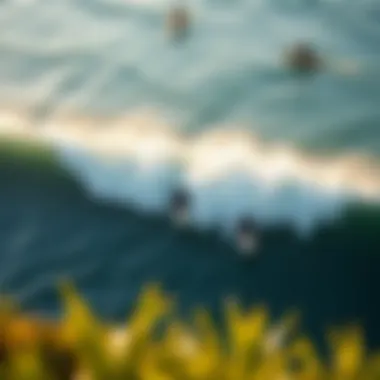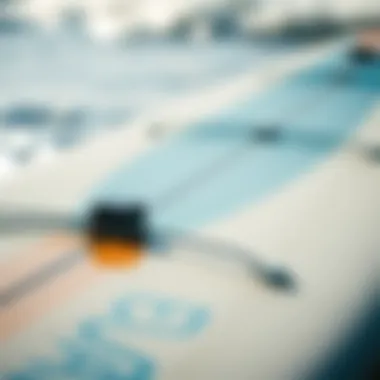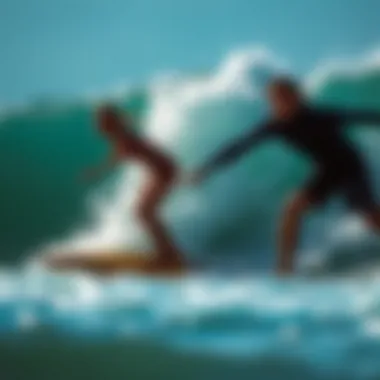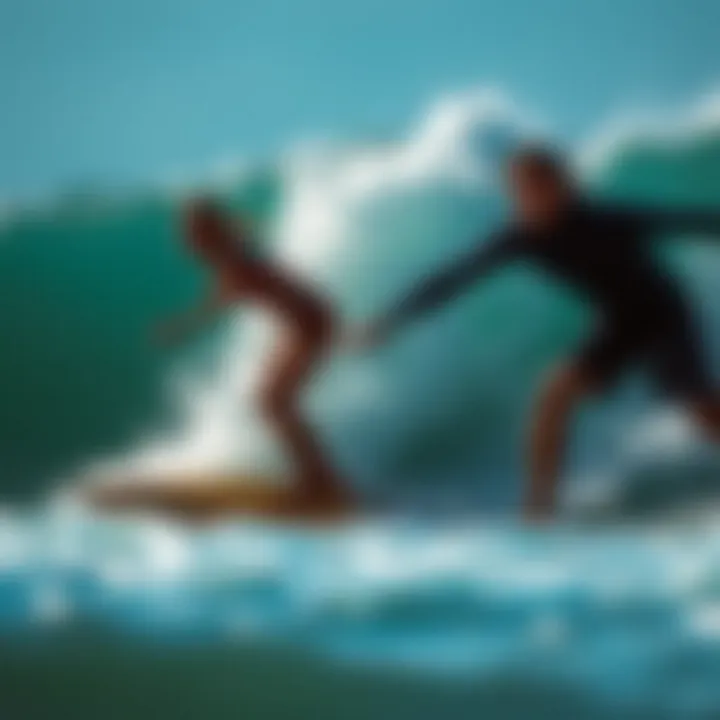Exploring the Depths and Dimensions of Surfing Culture


Intro
Surfing is not just a sport; it's a lifestyle deeply embedded in cultures around the globe. From the sun-soaked beaches of California to the rugged coastlines of Australia, the waves have become a canvas where surfers express their passion and artistry. This article will take you on a journey through the multifaceted world of surfing, exploring how it intertwines with technology, community, and the environment.
Gear and Equipment
To ride the waves, having the right gear and equipment is crucial. Surfboards come in various shapes and sizes, each catering to different experiences. Whether you’re a novice hoping to catch your first wave or a seasoned pro looking for performance, the right board can make all the difference.
Latest Surfboard Technologies
In today’s market, surfboards are more advanced than ever. Modern materials like epoxy and lightweight foam have taken center stage, decreasing weight and increasing durability. For instance, the use of carbon fiber rails on boards enhances performance by improving speed and responsiveness. Other innovations include the incorporation of hydrodynamic designs which help in navigating water more efficiently.
- Epoxy Boards: Lighter and more buoyant, these boards are popular among both beginners and experts.
- Fish Boards: With a wider body, these are perfect for smaller surf and allow for easier maneuverability.
Surfing tech doesn't stop with boards. Fins, wax, and leashes have also evolved, focusing on high performance and user-friendliness. High-performance fins help surfers maintain control while navigating choppy waters, and durable leashes ensure you won't lose your board in the surf.
Essential Accessories for Every Surfer
Every surfer has their bag of tricks when it comes to accessories. Some essentials to consider include:
- Wet Suits: Keep you warm in cooler waters while allowing flexibility.
- Surf Wax: Ensures a solid grip on your board, making it a basic but necessary item.
- Board Bags: Protect your investment from wear and tear during transport.
Buying quality gear will not only improve your performance but also enhance your overall surfing experience. With technology always improving, staying updated on the latest in surf gear is important.
Surf Techniques and Skills
Mastering surfing involves learning various techniques, regardless of your skill level.
Beginner Surfing Techniques
For beginners, the focus should be on mastering the basics. The ‘pop-up’ technique is foundational, allowing surfers to go from lying on the board to standing. Other important techniques include:
- Paddling: Essential for catching waves and returning to shore. Learn to breathe and paddle efficiently.
- Balancing: Finding your center of gravity helps maintain stability on the board.
- Wave Selection: Understanding which waves to catch can improve your chances of a good ride.
Advanced Maneuvers for Experienced Surfers
Once you’ve got the hang of the basics, you’ll likely want to explore advanced maneuvers. Skills like carving and aerials challenge your ability and enhance your surfing prowess. Advanced surfers often engage in:
- Cutbacks: A sharp turn that helps maintain speed and ride on the wave face.
- Aerials: For those looking to get air off the wave, this requires timing and skill.
- Tube Riding: Riding inside the wave’s hollow section, an impressive and challenging feat.
"The ocean stirs the heart, inspires the imagination, and brings eternal joy to the soul." - Wyland
The art of surfing is both technical and creative. Engaging with the surf culture opens up opportunities for community interaction, understanding environmental stewardship, and fostering personal growth. Each wave tells a story, and as surfers, we have the chance to be part of that narrative.
Preface to Surfing
Surfing is more than just a sport; it embodies a unique lifestyle and culture found in the rhythm of the waves. Understanding the world of surfing—its history, culture, and technique—is essential for anyone looking to grasp its full impact on society and the environment. Surfing has implications that reach far beyond the ocean, touching on a sense of community, environmental stewardship, and personal freedom. This foundational section aims to provide insight into these various aspects that form the backbone of the surfing experience.
Historical Context
To truly appreciate surfing today, it's crucial to look back at its origins. The practice of riding waves is believed to have started as early as 3000 BC in ancient Polynesia. The art was primarily a method of transport and fishing, gradually evolving into a recreational activity. Explorers like Captain James Cook documented this experience when they encountered locals riding waves on the islands of Hawaii.
The cultural significance of surfing in Hawaii cannot be overstated. Here, it has not only served as a means of connection with nature but also as a way to strengthen communal ties. The ancient Hawaiians practiced it as a ceremonial and ritualistic act, seeing themselves as stewards of the ocean. This perspective presents surfing not just as a leisure pursuit, but as an integral component of identity and spirituality.
Fast forward to the 20th century, surfing began to proliferate beyond its homeland. The introduction of surf culture to the mainland U.S. in the 1950s through films and rising celebrity surfers like Gidget—who popularized the sport among youth—changed the landscape drastically. The sport saw rapid growth in popularity, triggering a surfing boom that spawned its own fashion trends, music genres, and subcultures. What was once a local activity in Polynesia transformed into a global phenomenon impacting various aspects of life.
Cultural Impact
The impact of surfing on global culture keenly encapsulates its transformation from a niche pastime to a multifaceted lifestyle embraced by millions. Surfing has fostered a unique subculture that interlaces with music, art, and fashion. For instance, the correlation between surf rock music and the sport is a classic example of how cultural influences mesh together. Bands like The Beach Boys defined what surf culture sounded like, further embedding surfing into the fabric of popular culture.
Moreover, surfboards—once simply wooden structures carved for wave riding—have become canvases for artistic expression. They are painted and shaped by local artisans, reflecting the spirit of the community and its connection to the ocean.
Surfers often express a deep-seated reverence for nature, seeing themselves as ambassadors of ocean conservation. As waves crash and beaches become crowded, there’s a growing movement within the surfing community advocating for environmental awareness and sustainable practices. Initiatives to clean oceans and protect marine wildlife have gained traction, pushing back against the commercialism that often threatens these sacred spaces.
"Surfing is not just an escape from the world; it's a commitment to nature and community.
The nuances of cultural impact associated with surfing extend beyond the individual as well. Surf events around the world, whether competitions, festivals, or community gatherings, create opportunities for camaraderie among surfers. They bridge differences in age, race, and background, promoting inclusivity within the sport.
Understanding these dimensions of surfing can enrich the experience for both novices and seasoned practitioners alike. Ultimately, it reveals surfing’s role as both a mode of expression and a vital connection to a broader cultural narrative.


The Philosophy Behind Surfing
Surfing is more than just a sport; it's a way of life that embodies a profound philosophy. This philosophy is anchored in the experiences it offers—an escape from the mundanity of everyday life, a chase for thrilling waves, and a connection to the ocean and oneself. At its core, surfing teaches lessons about patience, harmony, and respect for nature. Understanding this philosophy elevates the practice from mere physical activity to an enriching psychological journey.
Mindfulness and Connection
The act of surfing calls for a unique state of mindfulness. When a person paddles out into the surf, there's a moment of pure presence; the mind quiets, the body engages, and the surrounding environment comes into sharp focus. It’s not about thinking of bills or deadlines but about understanding the rhythm of the ocean. When on the board, surfers often describe a feeling of being one with the waves, almost as if the water is an extension of themselves.
Surfing demands concentration, as even the slightest miscalculation can send a rider tumbling into the ocean. Thus, every session is a lesson in being present, appreciating the beauty around while also understanding one’s limits. This connection is not only with the ocean but also with a community of like-minded individuals, fostering a sense of belonging.
- The harmony between the surfer and the wave creates moments of grace.
- Engaging nature's elements fosters respect towards the natural world.
- Shared experiences within the surf community provide camaraderie and personal growth.
This convergence of focus and physicality means that many find surfing therapeutic. As one navigates through the surf, stress fades and clarity emerges, making each ride an exercise in emotional mindfulness.
The Pursuit of Freedom
Freedom is a central theme in the philosophy of surfing. There’s a distinctive exhilaration felt when riding a wave; it brings a quintessential sense of liberation. Each wave presents a new opportunity, a blank canvas awaiting the brushstroke of one’s skill and creativity. For many, the act of surfing encapsulates a break from societal constraints and pressures.
Surfers often embrace the unpredictability of nature, riding waves that differ not just in size but in temperament. It’s this ever-changing landscape that enhances the freedom associated with the sport. Whether riding the gentle breaks of a summer swell or tackling the roaring waves during winter, each session carries the charm of spontaneity.
"Life is a wave; you must make your own ride."
The pursuit of freedom in surfing extends beyond mere waves. Many surfers adopt a lifestyle that prioritizes experiences over possessions; friendships flourish, journeys unfold, and the world becomes a playground. This philosophy often leads to a reevaluation of priorities, shifting focus towards fulfillment rather than material gains.
Surfboard Technology
Surfboard technology is the backbone of the surfing experience. The design and materials used in surfboards profoundly influence performance, durability, and the overall riding experience. As surfers, we seek the right board that aligns with both our skills and the waves we wish to conquer. Understanding the nuances of surfboard technology not only enhances one's surfing performance but also deepens the appreciation for this sport by revealing the intricacies behind each wave-riding tool.
Material Innovations
When it comes to surfboard construction, material innovations have led to significant advancements. Traditional foam boards have given way to a variety of materials engineered for specific benefits. Today's surfboards often utilize materials such as epoxy, which is lighter and more durable than classic polyurethane. This shift allows for a smoother ride with increased buoyancy, which can be crucial when catching quick-breaking waves.
There’s also been a rise in eco-friendly materials in response to environmental concerns. Boards made from bio-resins or recycled materials show a growing awareness in the surfing community of our impact on oceans and beaches. Shaping a board with these materials can be a point of pride for surfers who value sustainability, allowing them to enjoy the sport while minimizing their environmental footprint.
"Investing in a high-quality surfboard isn't just about performance; it's an investment in the future of our oceans."
Design Evolution
The evolution of surfboard design is nothing short of fascinating. From the heavy wooden planks of ancient Polynesia to the high-performance shortboards used today, the design has continually adapted to fit the needs of surfers. Each decade brings about innovative designs that reflect broader trends in surfing.
For instance, the introduction of the thruster fin setup revolutionized maneuverability and stability. Surfers can now feel more in touch with the board, allowing sharper turns and creative expressions in the waves. Additionally, modern designs, such as fish and rocker shapes, cater to various surfing styles and conditions, showcasing how design is as much art as it is science. By analyzing wave patterns and typical surf conditions, shapers now develop boards that can maximize the rider's ability to perform consistently, regardless of the surf.
Performance Enhancements
Performance enhancements in surfboard technology have shifted the game for both amateurs and professionals alike. Improved hydrodynamics are achieved through meticulous testing of shapes and fin placements, which can drastically affect wave interaction.
With advancements like computerized shaping machines and testing pools, shapers can fine-tune their boards to perform under specific conditions, making surfing more accessible to beginners while allowing seasoned professionals to push their limits further.
Moreover, innovations such as integrated flotation systems and adjustable fins give surfers more control over their ride. These enhancements allow individuals to customize the handling of their boards, adjusting settings based on personal preference or changing wave conditions. For instance, a seasoned surfer may adjust their board setup to become more agile for a challenging day on the surf, while a newbie might want to focus on stability as they learn.
In summary, surfboard technology integrates craftsmanship and innovation, laying the groundwork for how surf culture evolves. It's essential not only for optimizing surfing performance but also in shaping the community's connection to surfing’s environment. Understanding these advances is crucial for anyone looking to make an informed choice when selecting their surfboard, as the right material, design, and performance features can make all the difference in riding the perfect wave.
Essential Gear for Surfing
The right gear can make a world of difference in a surfer’s experience, elevating not just performance but also the enjoyment of the sport itself. The equipment utilized in surfing is tailored to various conditions and individual preferences. Every surfer has to strike a balance between comfort, protection, and performance, and understanding the essential gear is paramount.
Wetsuits and Their Importance
A wetsuit may seem like a simple piece of equipment, but it plays a crucial role in a surfer's ability to perform and enjoy their time in the water. A good wetsuit provides insulation against cold water, buoyancy, and a layer of protection against abrasions and stings. The material, usually neoprene, traps a thin layer of water between the suit and the skin. As the body heats this water, it creates a warmer microclimate for the surfer.
Benefits of Wetsuits:
- Thermal Protection: Surfing in colder climates demands a wetsuit to stave off hypothermia. Without adequate thermal protection, the joy of riding waves quickly dissipates into discomfort.
- Flexibility: Modern wetsuits come in a variety of thicknesses and designs, allowing surfers to find one that not only keeps them warm but also allows for a full range of motion. Flexibility is key for executing maneuvers.
- Durability: Investing in a high-quality wetsuit can pay off in the long run. With proper care, a good wetsuit can withstand many seasons of wear, making it a worthy investment.
Wetsuits also come in various styles, including full suits, shorty suits, and even surf tops, depending on the wave conditions and personal preferences. Choosing the right wetsuit can make the difference between a memorable surf session and a shivering exit from the ocean.
Leashes, Fins, and Accessories
Besides wetsuits, there’s an array of other essential gear that keeps surfers safe and their performance optimized. The leash, fins, and various accessories have specific roles that are vital for both enjoyment and safety in the water.


The Importance of a Surf Leash:
A leash is a cord that connects the surfer’s ankle to the surfboard, and its importance cannot be overstated. It ensures that the board stays close by during wipeouts, preventing it from becoming a hazard to the surfer or others nearby.
Key Factors to Consider:
- Length and Thickness: The leash should ideally be slightly longer than the board while being thin enough to avoid drag. Different conditions might call for specific styles.
- Durability: Look for leashes made from high-quality materials that can withstand the rigors of big waves and rough conditions.
Fins and Their Role:
Fins are a significant part of the surfboard setup, affecting speed, control, and maneuverability. The variation in fin setup can significantly change how a board feels in the water. The choices range from single fins for stability to thruster setups for flexibility.
Accessories:
- Surfboard Wax: Helps to maintain grip on the board.
- Rash Guards: Protects the skin from rashes caused by prolonged contact with the surfboard.
- Travel Bags: Essential for protecting gear during travel, especially when heading to a surf destination.
In short, while it might seem tempting to hit the waves without a thought to gear, having the right equipment is half the game. It not only enhances performance but also ensures safety, allowing surfers to focus on what they love – the joy of riding those waves. For more information on surfing gear, visit resources like Wikipedia or Britannica.
"The right gear can turn an ordinary session into an extraordinary experience, bridging the gap between sandy shores and the thrill of the surf."
Surfing Techniques Explained
Understanding surfing techniques is crucial for anyone looking to ride waves. It's surprisingly more than just standing on a surfboard and hoping for the best; it's about mastering balance, timing, and movement. The right techniques can make the difference between a wipeout and riding the wave of your life.
Surfing involves various methods that cater to different skill levels. Some of them include learning the pop-up, mastering turns, and even tackling complex tricks that can impress others on the water. Whether you’re just starting out or have some experience under your belt, honing your skills can elevate the overall surfing experience.
Basics for Beginners
For those new to surfing, grasping the basics sets the foundation for future progress. Familiarity with your board and understanding the ocean are vital starting points.
- Choosing the Right Board: Beginners often benefit from wider, more stable boards, such as soft-tops. These boards are more forgiving and easier to balance on.
- The Pop-Up Technique: This is a crucial step in getting from lying down to standing up on the surfboard. Start by paddling forward in the water and, when you feel the wave pushing you, use your hands to push your chest upwards, bringing your feet under you in one smooth motion. Practice this on land if needed; it’s a game-changer.
- Paddling Basics: Learn the right way to paddle. Use long, deep strokes to maximize your speed and efficiency while trying to catch waves. Keep your eyes forward, not down, as it helps maintain balance.
It can seem overwhelming at first, but with practice, these techniques become second nature. Best advice? Don’t rush the process. Enjoying the journey is what surfing is all about.
Advanced Maneuvers
Once you’ve mastered the basics, it’s time to dig into the more intricate techniques that can elevate your surfing to another level. These maneuvers require dedication and a solid understanding of the dynamics of surfing.
- Carving Turns: This involves positioning your weight correctly as you pivot your board. Lean into your heels to carve into a turn, and use your arms for balance. It requires not just control but also a feel for the wave’s rhythm.
- Cutbacks: A very popular maneuver among experienced surfers. It requires performing a tight turn while moving back towards the breaking section of the wave, allowing you to keep your speed while redirecting your ride.
- Aerials: These jaw-dropping tricks see surfers launching off the lip of the wave into the air. While it’s certainly not for the faint-hearted, with practice, learning to time your take-off and land smoothly can lead to massive satisfaction.
The End
Mastering surfing techniques not only enhances your performance but also deepens your connection with the sport. Every ride, every maneuver teaches something new. In the world of surfing, improving your skillset can make each surf session a stepping stone towards achieving greater heights.
"In surfing, as in life, the journey is an adventure to be savored."
For more information and resources on improving your surfing techniques, check out surflibrary.com for tips from experts and fellow enthusiasts.
Further Reading
Whether you’re just getting your feet wet or are strutting your stuff on big waves, knowing surfing techniques empowers you to embrace the sport more fully.
Traveling to Surfing Destinations
Surfing is not merely an activity; it's an experience deeply tied to its locales. This topic unpacks the significance of traveling to surf spots worldwide, emphasizing not just the thrill of riding waves but also the cultural and ecological awareness that comes with it. For surfers and enthusiasts alike, these journeys are transformative, offering a gateway to diverse environments and enriching encounters.
Top Global Surf Spots
When it comes to surfing, some places have earned their stripes, establishing themselves as top-tier surf spots. Let's look into a few:
- Pipeline, Hawaii: Known as the "ultimate" wave and a rite of passage for many. The sheer power of the waves here demands respect.
- Gold Coast, Australia: Home to Snapper Rocks, this area boasts consistent swells and sandy beaches. It's a surfer's haven.
- Jeffreys Bay, South Africa: Recognized for its perfect right-hand point break, it has attracted surfers from all corners of the globe.
- Teahupo'o, Tahiti: With some of the heaviest waves on the planet, this spot offers challenges for seasoned surfers and awe-inspiring views.
- Mundaka, Spain: Not just a beautiful place, but also famous for its long left-hand barrel, which has captivated many.
The allure of these surf spots is undeniable. They draw surfers not just for the waves, but for the local culture, the food available, and the camaraderie among surf-lovers. The experience extends beyond the crashing waves; it’s about walking into a community that embraces its surfers.
Cultural Considerations in Surf Travel
Diving into a new surf destination isn’t just about catching waves; it’s about understanding and respecting the local culture. Engaging with local customs and practices brings depth to the surfing experience. Here are some essential points to consider:


- Respect Local Etiquette: Every surf spot has its guidelines. For instance, some places have specific unwritten rules about wave priority. Familiarizing oneself with these can prevent misunderstandings.
- Engage with the Community: Many surfers find joy in interacting with locals. Participating in cultural events or supporting local businesses benefits both the traveler and the community.
- Environmental Sensitivity: Coastal ecosystems are delicate. As surfers travel, they should be conscious of their environmental footprint, opting for eco-friendly practices where possible.
- Language and Communication: A simple "hello" in the local language goes a long way. It shows respect and can open up richer interactions with locals.
Traveling to surf destinations thus transforms a simple act of sport into a broader journey of discovery. Surfers become ambassadors for their home country while learning from diverse cultures around the globe.
"Traveling to surf spots is not just about the destination; it’s about the journey, the people, and the culture that shape our understanding of the world."
For further reading on surf culture and its impact, visit Wikipedia or check out the discussions on Reddit.
The Role of Community in Surfing
Surfing is not just an individual sport; it is deeply intertwined with a vibrant community that fosters bonds among enthusiasts and advocates for the sport. The essence of surfing often goes beyond the thrill of catching waves. It involves connection, shared experiences, and a mutual commitment to preserving the oceanic playground that surfers adore.
Surf Clubs and Collaborations
Surf clubs create a solid foundation for community engagement. They are a gathering place for surfers at all levels, offering a support network that enhances the overall surfing experience. Being part of a surf club means finding companionship with like-minded individuals who share a passion for riding the waves. Collaboration within these clubs often leads to numerous benefits:
- Skill Sharing: Members often exchange tips and techniques. A beginner could gain insights from seasoned locals who have braved diverse surf conditions.
- Social Events: Clubs frequently organize contests, barbecues, and beach clean-ups, helping to cultivate friendships and community spirit.
- Collective Advocacy: Groups can organize initiatives seeking to protect local surf spots from overdevelopment or pollution. By teaming up, surfers can have a louder voice in community affairs.
For instance, the local surf club in Malibu has long been at the forefront of beach preservation efforts, successfully advocating for policies that limit plastic waste in the ocean. Such grassroots efforts remind us that when surfers unite, they can effectively influence change.
Environmental Initiatives
As stewards of the coastlines, the surfing community holds a unique responsibility. Environmental initiatives led by surfers aim to preserve marine ecosystems and promote sustainability. This includes:
- Beach Clean-ups: Often organized by clubs or individual surfers, these events actively remove trash from beaches, preventing it from entering the ocean.
- Advocacy for Sustainable Practices: Many surfers are pushing for sustainable surfing gear, like eco-friendly surfboards made from recycled materials or environmentally safe waxes. These practices minimize the industry's carbon footprint, showcasing commitment to environmental health.
- Education Programs: Several organizations run workshops and programs to raise awareness about ocean conservation among surfers and general beachgoers.
"A surfer's bond with the ocean goes beyond the sport; it’s about taking care of the very waves we love."
By engaging in these initiatives, surfers not only enjoy their sport but also contribute positively to the planet. Embracing a collective responsibility, they demonstrate that a love for surfing is inseparable from a commitment to environmental stewardship.
In essence, the role of community in surfing transcends social gatherings and competitions. It is characterized by collaboration, advocacy, and a shared commitment to preserving the oceans and coastlines. As surfers continue to unite under these values, the impact of their community can resonate well beyond the waves, ultimately shaping a healthier, more sustainable future for surfing culture.
For more on surf community initiatives, visit websites like Surfrider Foundation and check out related discussions on Reddit.
Centuries of surfing have shown that the sport thrives on the relationships forged within the community. Through collective effort and passion, surfing can remain a cherished experience for generations to come.
The Environmental Impact of Surfing
When we think of surfing, images of crashing waves and the thrill of riding the swell often come to mind. However, the impact of this exhilarating sport extends beyond the immediate joy of the water. Surfing, while celebrated for its connection to nature, also brings forth a set of environmental challenges that need addressing. The conservation of oceanic and coastal ecosystems is a pressing concern due to the growing number of surfers and related tourism. Furthermore, as surf culture evolves, it brings with it a responsibility to ensure that our beloved wave-riding pastime does not come at the expense of the very environments that sustain it.
Sustainable Practices
In recent years, the surfing community has made significant strides toward adopting more sustainable practices. Here are a few noteworthy initiatives that surf brands and communities are championing:
- Eco-Friendly Board Production: Many companies are now developing surfboards using sustainable materials such as recycled EPS foam and eco-resin. Brands like Firewire and Tidy Boards are leading the charge, prioritizing environmental impact without compromising performance.
- Recycled Wetsuits: Manufacturers like Patagonia have introduced wetsuits made from recycled rubber and other eco-materials. This innovative shift not only reduces waste but also enhances the durability of the gear while keeping surfers warm.
- Beach Clean-Up Initiatives: Various surf clubs and organizations regularly organize events aimed at cleaning up local beaches. Surfers understand the direct correlation between clean waters and surf quality, making these initiatives essential.
Implementing these sustainable practices can lead to substantial benefits, not just for the environment but also for the surfers. Clean oceans often translate to better conditions for surfing, creating a win-win situation.
Preserving Coastal Ecosystems
Coastal ecosystems face numerous threats, including pollution, climate change, and habitat destruction. The surfing community plays a crucial role in protecting these natural environments through advocacy and responsible surfing practices. The preservation of coastal ecosystems can be fostered through:
- Reducing Plastic Use: By opting for reusable containers and avoiding single-use plastics at surf spots, surfers can minimize waste that often ends up in the ocean, harming marine life.
- Supporting Conservation Organizations: Many surfers actively partner with organizations like Surfrider Foundation, which works tirelessly to protect oceanic and coastal health. Supporting such initiatives not only helps preserve ecosystems but fosters a sense of community among surfers.
- Advocated for Policy Changes: The surfing community has also been known to vocalize the need for better coastal management policies. Engaging with local governments and advocating for the protection of natural habitats can lead to significant positive change.
"If we don’t protect our surfing environments, we risk losing the very thing that brings us together." – A Surfer’s Perspective
Future of Surfing
The future of surfing is a topic ripe with potential, weaving together technology, environmental shifts, and cultural evolution. As surfers, enthusiasts, or simply engaged observers, understanding what lies ahead can shape how we embrace this exhilarating sport. Navigating the intricate waters of surfing's future is crucial not only for the sport itself but also for our broader relationship with the oceans. You see, surfing is not just about riding waves; it encapsulates a lifestyle and a commitment to our natural world.
Technological Advancements
The waves of innovation are crashing in, and they are ushering in a new era for surfers. Technological advancements are set to change the face of surfing, making it more accessible and efficient while enhancing performance on the water. Here are some key areas where technology is making its mark:
- Smart Surfboards: Imagine a surfboard that can track your ride, analyze your technique, and provide feedback on your performance. Sensors embedded in surfboards can now measure metrics like speed, wave height, and time spent riding. This data can help surfers improve their skills, making the learning curve a little less steep.
- Wearable Tech: Think about smartwatches that connect with your surfboard or apps that track surf conditions in real-time. They can predict tides and wave patterns based on local weather conditions. This tech means that you will never miss the perfect wave again.
- Eco-friendly Materials: As surfboard construction continues in the light of environmental concerns, new materials are emerging that promise lower ecological footprints. Innovations include bio-resins and recycled materials that not only enhance durability but also lessen the impact on our beautiful beaches.
Embracing these technological enhancements might just be what keeps the surfing spirit alive, enabling bigger leaps both on and off the water.
Changing Coastal Dynamics
The coastal environments where surfing thrives are shifting, influenced by climate change and other human activities. Adaptation becomes vital in this evolving landscape. Here’s how the changing coastal dynamics unfurl:
- Rising Sea Levels: With the grim specter of climate change looming, rising sea levels threaten to alter popular surf spots. Some beaches may disappear altogether, while new ones could emerge. Understanding these dynamics will be crucial for surfers who need to keep an eye on their favorite surf locations.
- Ecosystem Changes: Coastal ecosystems are not static; they evolve, often in unexpected ways. Changes in fish populations and algae blooms can affect water quality and wave formation, which in turn impacts surf conditions. Surfers need to be aware of these shifts, lest they find themselves in less than ideal surfing scenarios.
- Environmental Policies: As surfing communities become increasingly aware of their oceanic playgrounds, engagement in local governance and environmental initiatives will rise. Collectively, surfers will need to advocate for sustainable practices and stronger protections for coastal resources, joining forces with other ocean enthusiasts.
"The ocean is a reflection of our actions. Surfing responsibly means preserving the beauty we love."
In summary, the future of surfing emerges through embracing tech advancements and adapting to changing coastal dynamics. The intersection of innovation and environmental accountability will not only define the way surfers interact with the waves but also direct the course of surf culture as it navigates the shifting tides of our world.







